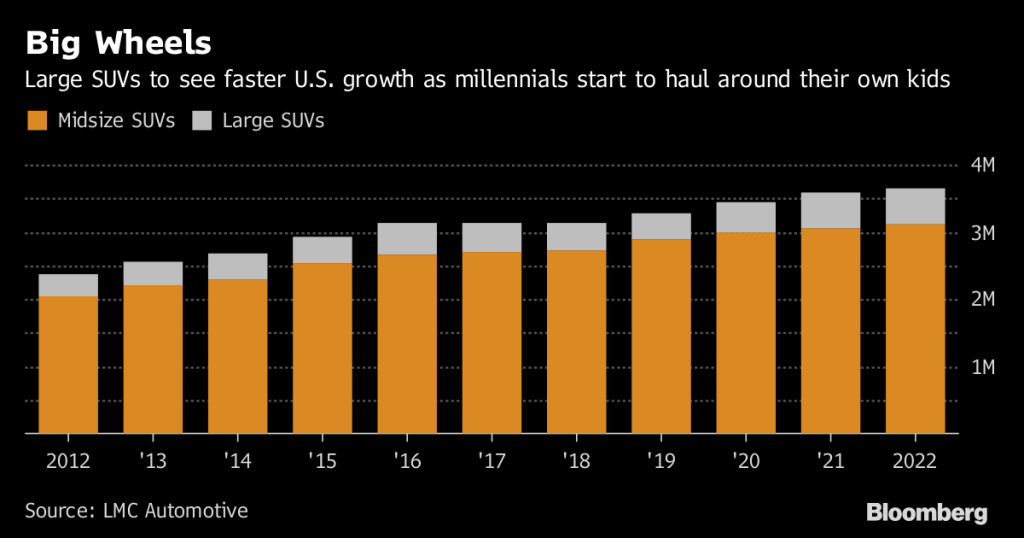這個年齡段的美國人最愛買房買車
|
據(jù)美國房地產(chǎn)網(wǎng)站Zillow Group的數(shù)據(jù),,18到34歲的青年一代已經(jīng)成為美國最大的買房群體,,其中有近一半的人生活在城市郊區(qū)。隨著生娃的需求迫在眉睫,,他們也越來越追求大戶型的房子,,同時也更加鐘愛大尺寸的汽車。據(jù)福特公司估算,,今年上半年,,美國大型SUV的銷量躍升了11個百分點,而中型和小型SUV的銷量只分別上漲了9%和4%,。 購車網(wǎng)站Autotrader分析師米歇爾·克雷布斯指出:“隨著青年人開始購房成家并且積攢起一定的財富,,他們對大型SUV的需求也在增長,。他們的第一部車可能是緊湊型SUV,不過成家之后,,他們的需求就發(fā)生了變化,。” |
Americans aged about 18 to 34 have become the largest group of homebuyers, and almost half live in the suburbs, according to Zillow Group data. As they shop for bigger homes to accommodate growing families, they’re upsizing their vehicles to match. U.S. industry sales of large SUVs have jumped 11 percent in the first half of the year, Ford Motor Co. estimates, compared with increases of 9 percent for midsize and 4 percent for small SUVs. “We do see that demographic group driving larger sport utility sales as they acquire homes, create families and gain some wealth,” said Michelle Krebs, an analyst at car-shopping website Autotrader. “They started with compact sport utilities and now, with families, they’re moving up.” |

|
年輕人在郊區(qū)買房的熱潮也讓他們的父母感到很驚訝,,美國的年輕人原本寧可不攢錢買房,,也不愿意在吃上委屈自己的肚子。前幾年也就是“千禧一代”剛剛大學畢業(yè)那幾年,,由于就業(yè)市場整體疲軟,,加上他們有一大堆助學貸款要還,很多年輕人都奉行晚婚晚育,,也沒有將買房提上議事日程,。隨著越來越多的年輕人漸漸克服了這些困難,他們也開始想過上“嬰兒潮”一代父母的生活——生娃,,在郊區(qū)買大房子,,開大排量SUV。 Zillow首席經(jīng)濟學家斯文賈·古德爾表示:“隨著越來越多的年輕人搬出父母的地下室——當然還有不少仍然住在那里,,我們認為,,對購房的健康需求還會繼續(xù)持續(xù)?!比ツ昵ъ淮呀?jīng)占到了美國所有購房者的42%,。“以前,,‘千禧一代’推遲了買房,、結(jié)婚和生子,,但現(xiàn)在他們做出了與父母非常相似的選擇,。” 嬰兒車,,兒童床 很多美國年輕人都傾向于購買三排座的大型SUV,,好有足夠的空間放下孩子的嬰兒車和便捷式的兒童床。據(jù)研究機購LMC Automotive預測,,從現(xiàn)在起到2022年,,中型SUV的銷量將增長16個百分點,而像福特征服者和雪佛蘭太浩這樣的全尺寸SUV的銷量則會猛增四分之一左右,。 據(jù)福特公司今年六月進行的一項調(diào)查顯示,,在“千禧一代”心目中,生孩子,、在郊區(qū)買房,、買一輛大號SUV的重要性,,要高于居住在核心城市或者用其他交通手段出行。 福特的美國銷售分析師埃里?!つ嗽诓稍L中表示:“年輕人的結(jié)婚年齡無疑是推后了,,但他們還是想要孩子的。只要他們開始生兒育女,,在孩子們成長和交友的過程中,,他們就需要更大的空間?!?/p> 今天,,美國中型和大型SUV的最大買主是35到44歲之間的中年人,。這代人又稱做“X世代”,,不過其人口總數(shù)顯著少于“千禧一代”的8000萬人。 更多的買主 默克表示:“未來10到15年,,又將有2500萬人邁進35到44歲的年齡階段,。大型和中型SUV的銷量也將呈現(xiàn)穩(wěn)步增長,這種趨勢現(xiàn)在已經(jīng)開始了,?!?/p> 最近幾年,緊湊型SUV的銷量已經(jīng)超過了豐田凱美瑞和本田雅閣等中型家轎,。默克并沒有說明福特公司是否認為中大型SUV的銷量會反超緊湊型SUV,。不過據(jù)福特公司預測,未來五到七年里,,美國汽車市場上SUV的占有率將從現(xiàn)在的40%上漲到45%,。 其中,千禧一代將成為購買SUV的絕對主力,。據(jù)美國疾病控制與預防中心的數(shù)據(jù),,目前,美國30至34歲女性的生育率已經(jīng)達到了1964年以來的最高水平,。 比如Zillow分析古德爾就買了一臺奧迪Q5:“以我為例,,我當然是需要大空間車型的,因為車子如果小了,,跟孩子一起出行是很不方便的,。”(財富中文網(wǎng)) 譯者:嚴匡正 |
The shift to suburbia may surprise those who’ve chided millennials for being more interested in pricey avocado toast than in saving for a home. Much of the generation delayed marriage, childbearing and home ownership after graduating with heaping student-loan debt and entering a weak job market. As more millennials overcome this, many want the life of their baby-boomer parents -- the kids, the house in the ’burbs and the beefy SUV. “As more people move out of their parents’ basement -- and there’s still quite a few living there -- we expect to see continued healthy demand for homes,” said Svenja Gudell, chief economist for Zillow, which found millennials made up 42 percent of homebuyers last year. “Millennials delayed home ownership, just like they delayed getting married and having kids, but now they’re making very similar decisions to their parents.” Strollers, Cribs More millennials are expected to move up into bigger SUVs with three rows of seats and enough cargo space for strollers and portable cribs. Sales of midsize SUVs will grow by 16 percent between now and 2022, while deliveries of the biggest rigs -- think Ford Expeditions and Chevrolet Tahoes -- will jump 25 percent, according to a forecast by researcher LMC Automotive. Millennials ranked having children, buying a suburban home and driving a big family vehicle higher in terms of importance than living in a major city or relying on alternate forms of transportation in a survey that Ford conducted in June. “There’s no question people are waiting longer, but people still want to have children,” Erich Merkle, Ford’s U.S. sales analyst, said in an interview. “As long as people have children and those children grow and acquire friendships, it requires more space.” Today, the largest group of midsize and large SUV buyers is between the ages of 35 and 44, Merkle said. That cohort, known as Gen X, is significantly smaller than millennials, who are about 80 million strong. More Buyers “There’s going to be an extra 25 million people passing into and through the 35- to 44-year-old demographic over the next 10 to 15 years,” Merkle said. “That’s going to lead to a gradual increase in the growth of large and midsize SUVs that’s already starting to happen.” Merkle wouldn’t say if Ford expected sales of larger SUVs to eventually outpace compact utilities, a segment that’s surged past family sedans like the Toyota Camry and Honda Accord. Ford forecasts that SUVs will grow to 45 percent of the U.S. market in the next five to seven years, from 40 percent now. Increasingly, that growth will be driven by millennials, the oldest of whom have lifted the annual birthrate for women 30 to 34 to the highest level since 1964, according to the U.S. Centers for Disease Control and Prevention. “As a sample size of one, I certainly need a lot of space because it’s really tough to travel with a child,” said Zillow’s Gudell, who drives an Audi Q5 SUV. |













